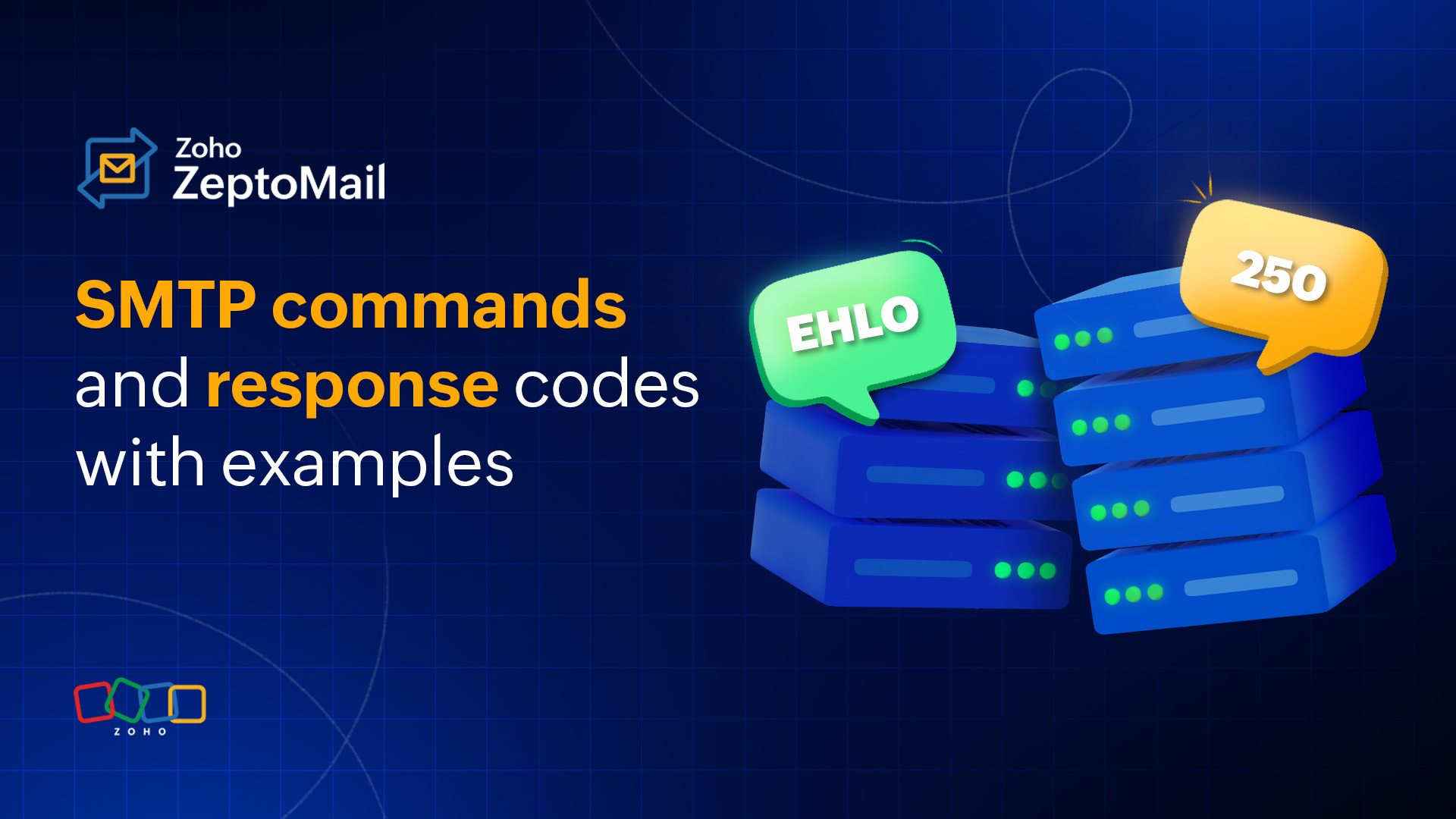- HOME
- Email sending
- The importance of a Mail Transfer Agent in email sending
The importance of a Mail Transfer Agent in email sending
- Published : October 1, 2024
- Last Updated : May 26, 2025
- 634 Views
- 6 Min Read
For most users, email sending is as simple as drafting and hitting send on an email on their computer. But in reality, email sending is far more complex with a vast email infrastructure responsible for the process. This email infrastructure has numerous elements—some with big responsibilities and some with small ones, but all equally important. While all of these elements play important roles in email sending, if we had to pick just one to be the star player, then it has to be the Mail Transfer Agent (MTA). In this article, we will see in detail about what the MTA is and what it does.

What is a Mail Transfer Agent?
A Mail Transfer Agent is responsible for the delivery of emails to the right recipient in an email infrastructure. An MTA is a software tasked with the transfer of an email and the associated data from one point to another point, often using the Simple Mail Transfer Protocol (SMTP). It can be within the same server or across servers depending on where the sender and recipient email is hosted. This makes MTA a very critical piece of the email-sending puzzle.
MTA uses a set of rules to make this email delivery possible. For the email delivery process, MTA carries out multiple operations.
MTA is often referred to using other terms, such as:
Mail server
Mail router
Internet mailer
Mail relay
Mail exchanger
MX host
Message Transfer Agent
Mail Transport Agent
No matter what it's called, the primary purpose of this element is to deliver the email to the recipient.
The role of MTA in email sending
Email is sent from the Mail User Agent (MUA), which is your email client, to the Mail Submission Agent (MSA).
MSA sends the email to MTA for delivery.
If the recipient is on the same server, MTA delivers the email to the recipient server directly. If not, the email is passed on to the relevant recipient MTA.
The recipient MTA hands the email over to the Mail Delivery Agent (MDA) and finally to the recipient MUA.
If the email cannot be delivered, MTA sends an intimation to the sender.
MTA has four main roles in this process:
Receives email from the MSA.
Looks up the recipient and pinpoints their location.
Hands over the email to the MDA to be delivered.
Sends a response if the delivery fails.
How does an MTA work? Store-and-forward model
MTA uses SMTP to deliver emails. This works on a store-and-forward model. This is especially useful during high-volume sending like transactional or bulk email sending. Once the MTA receives the emails, they're placed in a queue, waiting to be delivered. The MTA then tries to contact the recipient servers of the emails. If the recipient server is available, the emails are immediately delivered.
If the recipient servers are offline or busy, the emails are stored temporarily in the queue, and delivery is repeatedly attempted over a period of time. Once a positive response is received from the server, the email is delivered from the queue. If the email cannot be delivered for a specific period of time, the email is returned to the sender. This model helps manage email traffic seamlessly.
Main functions of a Mail Transfer Agent
The primary purpose of every Mail Transfer Agent is to deliver the email. But to make that possible, it has to perform multiple operations. Here are the main functions involved in the delivery of an email by the MTA.
Queueing
As previously mentioned, MTA works on a store-and-forward model. This makes queuing one of the primary operations of the MTA. Queuing is a temporary storage of emails lined up until the recipient servers are ready to receive the emails.
Throttling
To avoid overwhelming any particular receiving server, MTA performs email throttling. Email throttling is controlling the email sending to one particular domain or server. If the volume being sent is too high, MTA will send a certain number of emails and queue the rest. This helps both the receiving and sending server.
When a high volume of email is sent to a recipient server from a sending server, the bounce rate can spike if the recipient starts rejecting the emails. Additionally, the sender runs a risk of being marked as spam. Email throttling by the MTA can help avoid this.
Scheduling
Not all email deliveries need to be optimized for quick delivery. Sometimes, the email needs to be delivered at an optimal time for the recipient. MTA has scheduling capabilities that allow it to schedule delivery at a specific time based on multiple factors, such as time zone.
Network connections
Email transmission requires connections to be established between the sender and recipient. MTA is responsible for managing these connections across the network, which includes initiating the connection, maintaining the connection, and terminating it once the email transmission is complete.
Transmitting data
As part of the email sending process, MTA is also responsible for transferring the email content and associated media files to the recipient. In order to deliver the email, the data has to be transmitted through different points on the network.
Handling temporary failures
Every delivery attempt by the MTA isn't successful. When there is a temporary failure of delivery, the MTA is responsible for handling it. The email is then returned to the queue for delivery at a later point.
Generating bounce responses
When there is a permanent failure of delivery, the Mail Transfer Agent is responsible for generating the bounce message to the sender. The MTA will generate and transmit the bounce message to the sender's email server for all undelivered emails to keep them informed of their email status.
Monitoring email status
Mail Transfer Agent operations include extensive logging and monitoring for all emails that pass through it. The MTA logs details like the date and time of the email, recipient address, delivery status, and more.
Optimal routing
The MTA is tasked with the primary goal of email delivery but there are multiple routes that the delivery could happen through. The MTA will choose the most optimal route for email delivery from the sender's email server to the recipient's email server.
Email protocol management
A Mail Transfer Agent uses SMTP to send emails. The MTA is tasked with handling these protocols to enable email delivery. On the recipient's end, Post Office Protocol (POP) or Internet Message Access Protocol (IMAP) will be used to retrieve emails that have been delivered.
Spam and virus filtering
While this operation isn't always mandatory, many MTAs include built-in spam and virus filtering capability. When an email is received by the MTA, the email is scanned for spam and malware to block these malicious email messages.
Email encryption
The Mail Transfer Agent also provides additional security to the emails. The MTA encrypts the email using TLS during delivery.
The benefits of a Mail Transfer Agent
Reputation protection
By regulating email sending volume, throttling, and handling bounces and delivery failures, Mail Transfer Agents contribute to better sender reputation.
IP warm-up
For new IPs, it's always best to gradually increase the volume of email sending over a period of time to avoid being perceived as suspicious. MTAs help manage this warm-up process to build a better IP reputation.
Consistent volume
Consistent email sending without sudden drops or spikes in volume is key for good deliverability. Because MTAs monitor and regulate the email sending flow, it helps keep the email sending volume consistent.
Greylist delivery
If the recipient server is unsure of the sender, they sometimes choose to greylist the email where the email is temporarily rejected. The MTA will then queue the email and strategically retry multiple times until the email is accepted.
Avoiding spam filters
MTA plays a role in preventing the email from being flagged as spam. The following operations by the MTA helps with:
Email throttling: If there's a high sending volume to a particular domain or server, MTA will regulate the email sending to avoid being marked as spam.
Routing: The MTA choose the routes of email delivery less likely to be filtered as spam.
Bounces: MTA generates and relays bounce messages in case of failed email delivery.
Wrapping up
The Mail Transfer Agent takes center stage when it comes to the infrastructure involved in email sending. It's important that your email provider uses and manages the MTA well to maintain good deliverability for your emails, especially for high-volume emails like transactional emails. At Zoho ZeptoMail, industry-standard practices are followed to ensure that your transactional emails are delivered reliably and securely.

